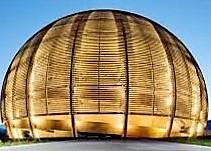Speaker
Description
We report on a precise mass measurement of 69Co and 70Co performed at the IGISOL facility [1].
The nuclear structure above the N=40 subshell closure remained for long unclear due to lack of information on neutron-rich nuclei in this region. This region is known for shape coexistence and intruder states have been observed in neutron-rich cobalt isotopes toward N=40 [2]. The two-neutron separation energies and the empirical two-neutron shell-gap determined from the mass value give important insight on the evolution of the subshell closure. In nuclear astrophysics, the 68Co(n,γ)69Co reaction have been highlighted in sensitivities studies to strongly influence the abundance pattern for the weak r process, which produces the lightest r-process elements [3]. The ratio of the photodisintegration to the neutron-capture rate depends exponentially on the reaction Q-value, stressing the need of precise mass value.
The double Penning trap JYFLTRAP [4] at the University of Jyväskylä has been successfully used to measure the masses of 12 nuclides in the N=40 region. Among these, the masses of 69Com and 70Co were determined for the first time [1]. The isotopes of interest were produced via proton-induced fission at the IGISOL facility [5] during one week of experiment. The time-of-flight ion cyclotron resonance (TOF-ICR) technique [6] was used for the mass measurements. The ½- isomer in 69Co has been determined via ion beam manipulation technique, taking advantage of the difference of half-lives between the ground and the isomeric state in 69Co. In addition, the phase-imaging ion cyclotron resonance technique (PI-ICR) [7] was used for the first time online to determine the composition of the 70Co beam and the long living state of 70Co was precisely determined. Our experimental data were compared to large-scale shell model calculations and confirm the weakening of the N=40 subshell closure below nickel. We also considerably reduced the mass-related uncertainty in the photodisintegration rate 69Co(γ,n)68Co and in the ratio of the photodisintegration to the neutron-capture rate.
In this talk, the experimental method and the impact of our results on astrophysics and nuclear structure in the N=40 region will be discussed.
[1] L. Canete et al., Phys. Rev. C 101, 041304 (R) (2020).
[2] F. Recchia et al., Phys. Rev. C 85, 064305 (2012).
[3] R. Surman et al., AIP Advances 4,041008 (2014).
[4] T. Eronen et al., Eur. Phys. J. A 48, 46 (2012).
[5] I. Moore et al., Nucl. Instrum. Methods Phys. Res. B 317, 208 (2013).
[6] M. König et al., Int. J. Mass Spectrom. Ion Process. 142, 95 (1995).
[7] S. Eliseev et al., Phys. Rev. Let. 110, 082501 (2013).
